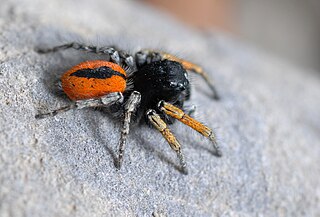
Philaeus chrysops is a species of jumping spider (Salticidae).

Eresus sandaliatus is a species of spider found primarily in northern and central Europe. Like other species of the genus Eresus, it is commonly called ladybird spider because of the coloration of the male.

Evarcha is a genus of spiders in the family Salticidae with 85 species distributed across the world.
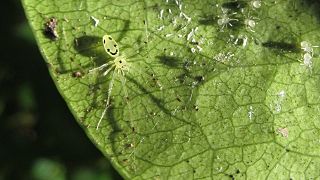
Theridion grallator, also known as the Hawaiian happy-face spider, is a spider in the family Theridiidae that resides on the Hawaiian Islands. T. grallator obtains its vernacular name of "Hawaiian happy-face spider" from the unique patterns superimposed on its abdomen, specifically those that resemble a human smiling face. T. grallator is particularly notable because of its wide range of polymorphisms that may be studied to allow a better understanding of evolutionary mechanisms. In addition to the variety of color polymorphisms present, T. grallator demonstrates the interesting quality of diet-induced color change, in which its appearance temporarily changes as it metabolizes various food items.

Evarcha culicivora is a species of jumping spider found only around Lake Victoria in Kenya and Uganda. At maturity, E. culicivora spiders have an average size of 5 mm for both males and females. The range in size for either sex is quite small, with females being only slightly larger on average.

The nursery web spider Pisaura mirabilis is a spider species of the family Pisauridae.

Spider cannibalism is the act of a spider consuming all or part of another individual of the same species as food. In the majority of cases a female spider kills and eats a male before, during, or after copulation. Cases in which males eat females are rare.
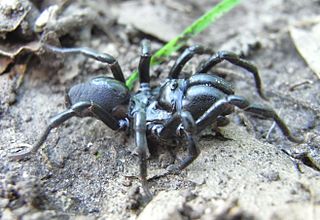
Atypus piceus is a mygalomorph spider of the family Atypidae. It occurs in Europe to Moldavia, and Iran and is the type species of the genus Atypus.
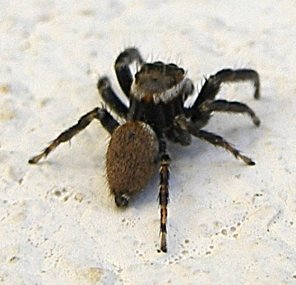
Evarcha jucunda is a species of jumping spider.
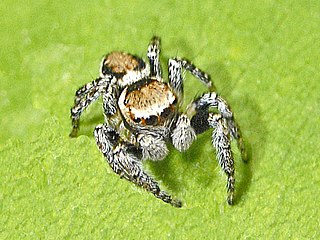
Evarcha falcata is a species of 'jumping spiders' belonging to the family Salticidae.

Larinioides cornutus, the furrow spider, furrow orb spider, or foliate spider is an orb-weaver spider with Holarctic distribution.

Titanoeca quadriguttata is a species of spider in the family Titanoecidae. It is widespread in Europe, though absent from Great Britain, and is found in Austria, Belgium, Bulgaria, Corsica, Croatia, Czech Republic, France, Germany, Greece, Hungary, Italy, Liechtenstein, Moldova, Russia, Slovakia, Spain, Switzerland, the Netherlands, Ukraine.
A. frontalis may refer to:

Carrhotus xanthogramma is a species of 'jumping spiders' belonging to the family Salticidae.
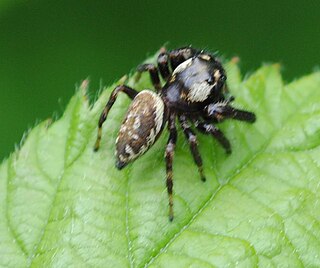
Macaroeris nidicolens is a species of jumping spider that occurs from Europe to Central Asia.

Xysticus cristatus, the common crab spider, is a European spider from the family Thomisidae.

Macracantha is a genus of Asian orb-weaver spiders recognized as containing the species, Macracantha arcuata., although some schemes also recognise inclusion of Gasteracantha hasselti in this genus. Macracantha is notable for the extremely long, curved spines on the abdomens of female members of the genus; Eugène Simon created the taxon name from the Greek words μακρός and ἄκανθα (spine). It occurs from India and China through Southeast Asia to Borneo.
Evarcha brinki is a jumping spider species in the genus Evarcha. It has more similarities with Evarcha species from China, like Evacha sichuanensis and Evarcha orientalis, than many African species.
Evarcha bakorensis is a jumping spider in the genus Evarcha. The male was first described in 2002 and the female in 2011.
Evarcha ignea is a jumping spider species in the genus Evarcha that lives in Nigeria, South Africa and Zimbabwe. The male was first described in 2008 and the female in 2013.


















